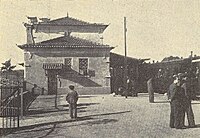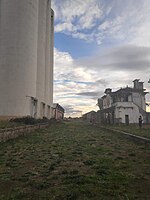Mogadouro railway station
Mogadouro Station Estação Ferroviária do Mogadouro | |
|---|---|
 Mogadouro station in 2008 | |
| General information | |
| Location | Mogadouro Portugal |
| Coordinates | 41°20′03.11″N 6°39′02.63″W / 41.3341972°N 6.6507306°W |
| Elevation | 770m |
| Line(s) | Sabor line (1930-1988) |
| Distance |
|
| Connections | |
| Other information | |
| Website | |
| History | |
| Opened | 1 June 1930 |
| Closed | 1 August 1988 |
| Location | |
The Mogadouro railway station, part of the now closed Sabor Line, was a rail interface that served the town of Mogadouro, Bragança District, Portugal.
Description[edit]
The Mogadouro station was 5.8 km from the town of the same name, via the EN221.[1] It consists of a passenger building (located on the northwest side of the track),[2] a covered pier, an electrical building, a water tank, a workshop and staff quarters.[3]
Exterior[edit]
The passenger building has a polygonal floor plan and two-storey façades, plastered and painted white, bordered by an ashlar pediment and, on the façade facing the line, an ashlar of polychrome azulejos, and topped by a double frieze and cornice of ashlar, the lower one incorporating a frieze of polychrome patterned azulejos.[3]
There are toponymic azulejo panels on the lateral façades. The main façade faces west. On the rear façade, the central panel has a porch with carved granite columns.[3]
Interior[edit]
Inside, the first floor was used for the service area, with a telegraph office, dispatches and the ticket office, with a small wooden window with an arched opening, preserving a metal guard that limited passenger access to it, and the wooden structure of another ticket office, as well as the public area with a waiting room.[3]
The second floor, accessed by external side staircases on the north façade, was used to house the stationmaster and his family, keeping the areas well defined. The walls are covered in tiles in a geometric, polychrome pattern.[3]
History[edit]
Construction and inauguration[edit]
In July 1926, it was announced that work would resume on the stretch of the Sabor Line between Carviçais and Mogadouro, after a long period of suspension.[4]
On 1 June 1930, the section between Lagoaça and Mogadouro was put into service[5] by the Companhia Nacional de Caminhos de Ferro.[6] However, the track laying and building works were only completed in 1932; even so, the General Directorate of Railways, which inspected the project in February of that year, ordered the installation of some more infrastructure, including a house for manual workers and an uncovered pier at Mogadouro station.[6] Due to delays in approval, these works only began in August and were almost finished by the beginning of the following year.[6]

In 1933, a three-storey house was built at the station for the staff.[7] That year, a decree was also submitted to the Minister of Public Works and Communications for approval regarding the expropriation of a plot of land next to the station for the installation of a sleepers creosoting workshop.[8] This building was constructed the following year, in 1934.[9]
Continuation to Duas Igrejas - Miranda[edit]
The next section of the Sabor Line, to Duas Igrejas - Miranda, was inaugurated on 22 May, 1938.[5]
Transversal of Chacim[edit]
Decree 18:190 of 28 March 1930 introduced the General Plan for the Railway Network, the aim of which was to regulate railway line projects in Portugal. One of the planned connections was the Transversal of Chacim, from Macedo de Cavaleiros, on the Tua line, to Mogadouro.[10]
This section, which would be around 50 kilometres long,[11] would form part of the Transversal of Trás-os-Montes, which would connect the narrow gauge lines north of the Douro River: Sabor, Tua, Corgo, Tâmega and Guimarães.[12] The Transversal of Chacim was never built.
Closure[edit]
The Sabor line was closed on 1 August 1988, leading to the abandonment of the Mogadouro station.[13][14]
Plans to reopen the line were made throughout the years but none has yet been implemented.
Gallery[edit]
-
Photo of the Mogadouro station in 1938 at the inauguration of the rail section between it and Duas Igrejas - Miranda.
-
A priest blessing the first train that crossed the Mogadouro - Duas Igrejas section of the Sabor Line, 22 May 1938.
-
The surroundings of the Mogadouro railway station, 2 October 2021.
See also[edit]
References[edit]
- ^ "Cálculo de distância rodoviária". Google Maps. Retrieved 2021-10-15.
- ^ (anónimo): Mapa 20 : Diagrama das Linhas Férreas Portuguesas com as estações (Edição de 1985), CP: Departamento de Transportes: Serviço de Estudos: Sala de Desenho / Fergráfica — Artes Gráficas L.da: Lisboa, 1985
- ^ a b c d e "Estação Ferroviária de Mogadouro" [Mogadouro Railway Station]. www.monumentos.gov.pt (in European Portuguese). Archived from the original on 13 March 2024. Retrieved 13 March 2024.
- ^ "Linhas Portuguesas" (PDF). Gazeta dos Caminhos de Ferro. Ano 39 (925): 208. 1 July 1926. Retrieved 11 March 2024 – via Hemeroteca Digital de Lisboa.
- ^ a b "Troços de linhas férreas portuguesas abertas à exploração desde 1856, e a sua extensão" (PDF). Gazeta dos Caminhos de Ferro. Vol. Ano 69, no. 1652. 16 October 1956. p. 528-530. Retrieved 16 August 2014 – via Hemeroteca Digital de Lisboa.
- ^ a b c "Ainda o que se fez nos Caminhos de Ferro em Portugal no ano de 1932" (PDF). Gazeta dos Caminhos de Ferro. Vol. Ano 46, no. 1082. 16 January 1933. p. 61-63. Retrieved 16 August 2014 – via Hemeroteca Digital de Lisboa.
{{cite news}}: CS1 maint: url-status (link) - ^ "O que se fez nos Caminhos de Ferro em Portugal no Ano de 1933" (PDF). Gazeta dos Caminhos de Ferro. Vol. Ano 47, no. 1106. 16 January 1934. p. 49-52. Retrieved 16 August 2014 – via Hemeroteca Digital de Lisboa.
- ^ "Direcção Geral dos Caminhos de Ferro" (PDF). Gazeta dos Caminhos de Ferro. Vol. Ano 47, no. 1106. 16 January 1934. p. 53. Retrieved 16 August 2014 – via Hemeroteca Digital de Lisboa.
- ^ "O que se fez nos caminhos de ferro em Portugal, em 1934" (PDF). Gazeta dos Caminhos de Ferro. Vol. Ano 47, no. 1129. 1 January 1935. p. 27-29. Retrieved 16 August 2014 – via Hemeroteca Digital de Lisboa.
- ^ Portugal. Decreto n.º 18:190, of 28 March 1930. Ministério do Comércio e Comunicações - Direcção Geral de Caminhos de Ferro - Divisão Central e de Estudos - Secção de Expediente, Published in Diário do Governo n.º 83, Série I, of 10 April 1930.
- ^ de Sousa, José Fernando (1 June 1935). "A Crise Actual de Viação e os nossos Caminhos de Ferro de Via Estreita" (PDF). Gazeta dos Caminhos de Ferro. Vol. Ano 47, no. 1139. p. 235-237. Retrieved 5 January 2015 – via Hemeroteca Digital de Lisboa.
- ^ de Sousa, José Fernando (16 June 1935). "Caminhos de Ferro em Trás-os-Montes: o que a lei manda" (PDF). Gazeta dos Caminhos de Ferro. Vol. Ano 47, no. 1140. p. 262-272. Retrieved 5 January 2015 – via Hemeroteca Digital de Lisboa.
- ^ "Saudades do comboio na Linha do Sabor". Público (in Portuguese). 5 December 2009. Archived from the original on 29 September 2023. Retrieved 13 March 2024.
- ^ REIS et al, 2006:150
Bibliography[edit]
- Reis, Francisco; Gomes, Rosa; Gomes, Gilberto; et al. (2006). Os Caminhos de Ferro Portugueses 1856-2006. Lisbon: CP-Comboios de Portugal e Público-Comunicação Social S. A. p. 238. ISBN 989-619-078-X.




